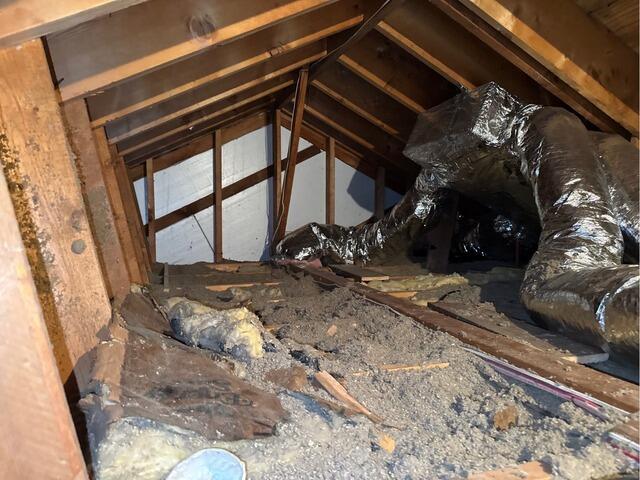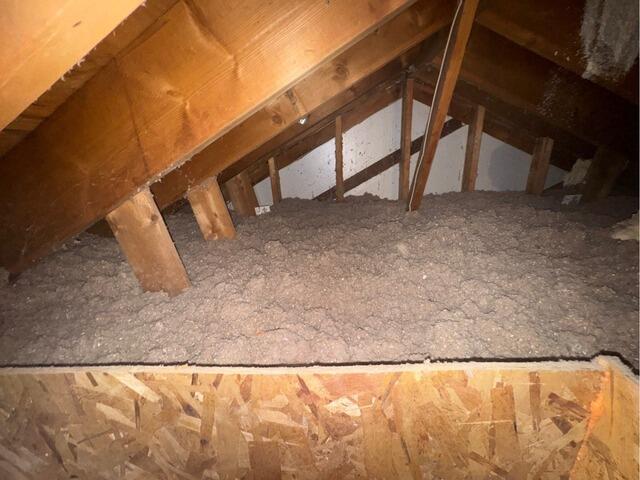Before & After Photos
Click on a photo to enlarge.
Cleaning up a Crawlspace in Stafford Springs, CT
This homeowner in Stafford Springs, CT knew he had to upgrade the insulation in his crawlspace. Even at a quick glance it is clear that the old insulation was sagging and falling off the crawlspace ceiling, which leaves space for cold air to push up into the home causing cold floors and making the home harder to heat.
We started by pulling out the old, ineffective insulation. We then installed our SilverGlo foam board with special long screws and sealed any seams. SilverGlo is not only an excellent insulator, but it's not sagging or budging any time soon.
Thanks to Dr. Energy Saver by Eco Energy Solutions, this homeowner no longer has to worry about the cold seeping up into the home for the foreseeable future.
Stop Air Leakage Around Chimney in Stafford Springs, CT
Our customer in Stafford Springs, CT called Fogarty's Home Services with concerns regarding drafts and the effectiveness of her attic insulation. When our Home Comfort Specialist arrived and performed a Free Home Energy Evaluation for her, he noticed open air space between the chimney and the lack of proper insulation. We prepared the chimney for insulation by sealing the chimney chase with metal flashing. We then installed fireproof panels to insulate the area around the chimney and prevent air leakage. The attic was then air sealed and insulated with TruSoft™ cellulose insulation. This keeps the temperature-controlled air the customer is paying for INSIDE the home, lowering her energy bills and saving her money!
Making a Basement in Storrs Mansfield, CT Warmer
These homeowners in Storrs Mansfield, CT had issues with their basement being cold and energy bills being high. For those with laundry set ups in the basement, it is extra important for the basement to be comfortable and not have to worry about freezing pipes. Not only that, but a basement that is not properly air sealed will let cold air from outside up into the home, making the heating system work harder to keep the home warm.
There was ineffective fiberglass insulation that we had to remove before starting our process, it was starting to fall apart and would only deteriorate further if left in. We sealed the rim joist with expanding foam and installed our Foamax polyiso insulation foam board onto the walls with our Foam-Tite fasteners. Foamax has flame retardant properties as well as a foil facing to reflect heat to keep it in.
Thanks to Dr. Energy Saver by Eco Energy Solutions, these homeowners will no longer have to be uncomfortable in their basement or worry about high energy bills.
Insulating an Attic in Storrs, CT
This homeowner in Storrs, CT called us hoping that we would be able to help him with his attic insulation. He had old loose fill insulation that needed to be replaced. In the winters, he experienced ice damming, and in the summers, he had a bad humidity problem. He also had a mold problem, and there were rodents and bats that were entering his attic. He wanted to remove all of those issues and start fresh with new insulation to increase his home comfort.
We were able to help this customer! We were able to replace the attic insulation with TruSoft™ cellulose insulation. We started by removing the old blown-in insulation using a large vacuum. We then went in and air-sealed around all of the points where air leaks up from the home to the attic. We did this using our Zypfoam™ spray foam. Once the atitc is air sealed, we used a long hose to blow in TruSoft™ cellulose insulation. TruSoft™ is amazing -- it does not burn, get moldy, or attract pests. The blown-in insulation fills all gaps and oddly shaped voids. The homeowner is now much more comfortable in his home!
Air Sealing Can Lights in Salem, CT
Many homes have recessed lighting. Can lights are a major source of air leakage from the conditioned space into the unconditioned attic space. Most of these lights use incandescent or halogen bulbs which burn at 380 degrees. Hot air rises faster so the air leaks faster. We used our TiteShell can light covers which are safe to use around hot light fixtures. Once the covers are fitted around the fixture they are air sealed with expanding foam.













